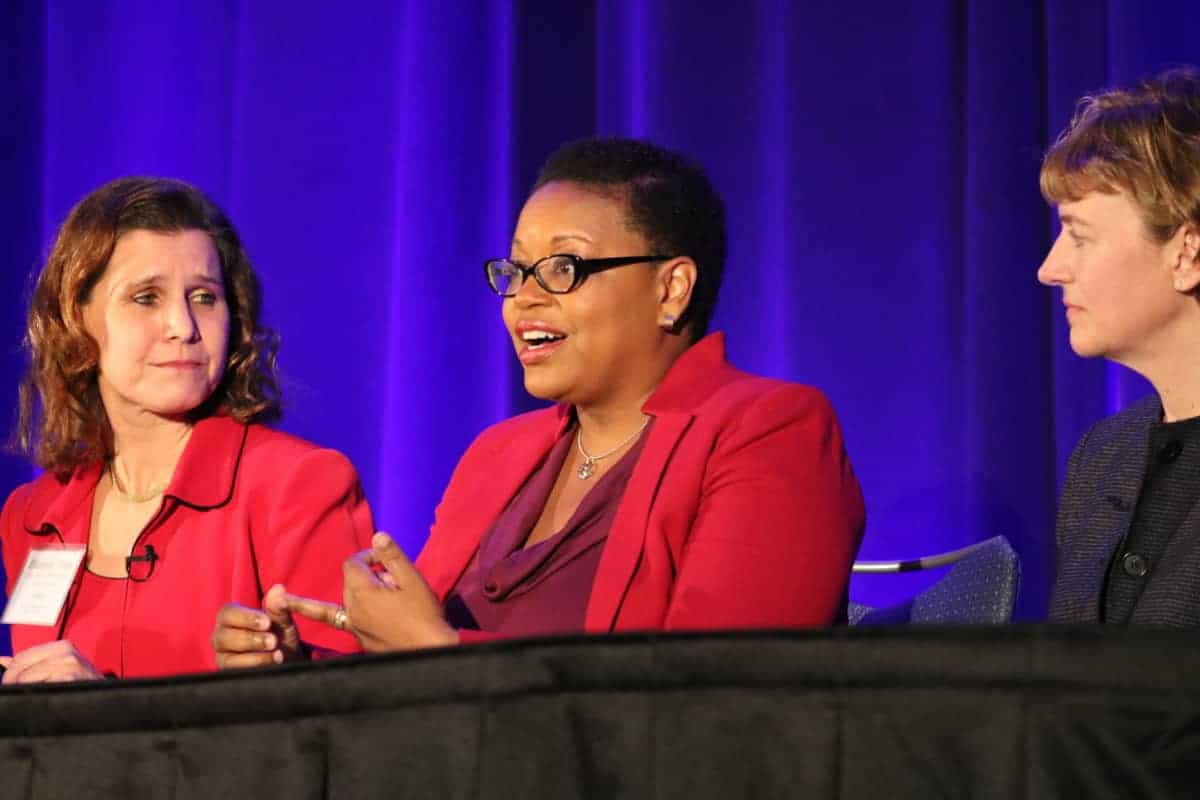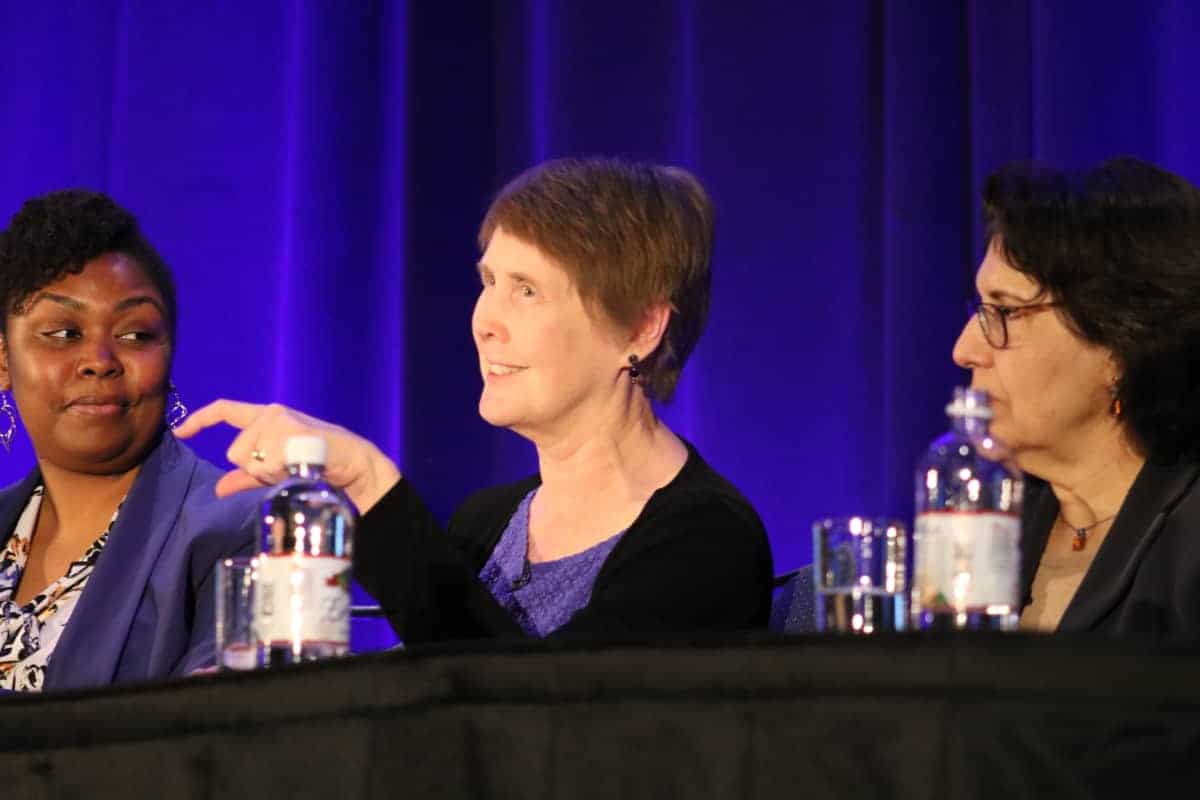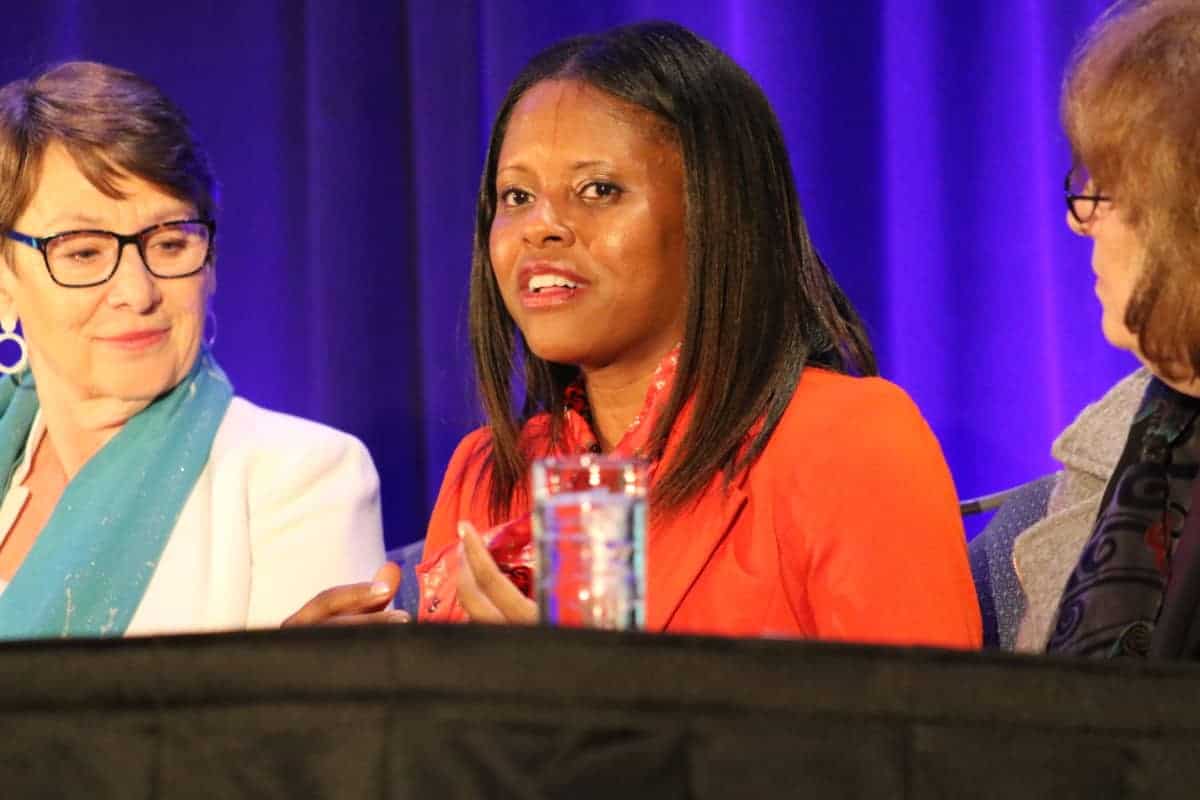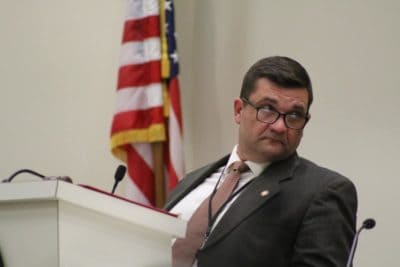The state’s youngest children — how to improve health and education outcomes for them, their families, and their communities — were at the forefront of conversations at the Early Childhood Summit Wednesday. Researchers, policymakers, philanthropists, and early childhood leaders met in Raleigh for the launch of the Department of Health and Human Services’ (DHHS) Early Childhood Action Plan.
The plan, developed in response to an executive order from Gov. Roy Cooper, provides 10 statewide goals around early childhood health, development, and learning, along with measures for tracking progress for each goal. The goals delve into issues of food insecurity, child abuse and neglect, racial disparities in infant mortality rates, homelessness, foster care, social and emotional health, high-quality child care access, kindergarten readiness, and reading proficiency.
“I think the future of our state’s prosperity depends on our commitment today to this Early Childhood Action Plan,” said DHHS Secretary Mandy Cohen. “Our businesses need quality child care to support working families. Our economy needs healthy and productive citizens to thrive.”
In his opening remarks, Cooper spoke of a statewide obligation to set a solid foundation for young children, especially those born into tough circumstances.
“We know that it starts early,” Cooper said. “We know that when we’re holding that child and looking at he or she in our arms, completely, totally helpless, 100 percent dependent on that person who is holding her, on that family that she is born into, on that community, on that state. It’s our responsibility. And from the minute that child is born, things are happening. Everything matters. And we know that with this Early Childhood Plan, we have components that we can put in place to make sure that that child is healthier, that that child is smarter, that that child is more emotionally stable, that that child is as much on an equal plane for opportunity as any other child in the state.”
Cooper shared some priorities on a “plan of attack,” beyond the action plan’s goals and measures. He held up a robust tax base, cross-sector partnership, and Medicaid expansion as strategies to work towards the plan’s goals. He highlighted the business community as strong advocates for the early childhood field. CEOs of the largest tech companies in the state have repeatedly pushed for the expansion of NC Pre-K, the state’s preschool program that targets low-income 4-year-olds. When it comes to health care, Cooper said around $4 billion in federal funding could be used to improve parent and child health.
“Talking to pediatricians who are trying to keep kids healthy, and we know that kids are covered by medical insurance, they say the fact that so many of their parents don’t have medical insurance, that it affects the health of the child,” he said. “They don’t see the doctor as much. There’s not as many well checks as they need, and health problems affecting parents often affect the health of the child.”
Former Gov. Jim Hunt, who created the backbone of the early childhood system across the state in the 1990s, called on the audience to push early childhood education and development to the top of the issues North Carolinians think about.
“Are we doing what we ought to do for human beings?” Hunt said. “There’s nothing more important than helping them get a good start, for those little children, to feel like they’re important, not to feel like they’re being slapped around and told they’re no good. They are good. They have enormous potential. But they need to be in early good homes, and some of the homes need extra help so that those children all feel like they’re important, like they can be somebody.”
Hunt’s legacy as an early childhood pioneer, and North Carolina’s history of early childhood investment, was spoken of throughout the summit. The keynote speaker, Dr. Jack P. Shonkoff, a Harvard University professor of child health and development and pediatrics, challenged the audience to focus on new ideas based in rapidly growing scientific research.


“I’m going to kind of make a bold assertion here, which is that the field doesn’t have as bright a future going forward if we just rest on 20th century knowledge and advocacy and don’t take advantage of leveraging the revolution that’s going on in science right now,” Shonkoff said.
He said throughout the second half of the 20th century, important strides were made in raising the first years of life as important ones for health and education. North Carolina has contributed to the field, he said, in many ways.
“I think the best tribute to Governor Hunt and … the important part of Governor Cooper’s agenda, is to not say we finally fully funded and got complete access to what Gov. Hunt and his colleagues thought of 25 years ago, but that North Carolina ought to be regaining its leadership role for 21st century early childhood development.”
He first encouraged the early childhood leaders in the room to focus on differentiation of programs and services. When one strategy works for some people, he said to look at the outliers in data and ask why the program worked very well for some individuals and very poorly for others. Twenty-first century science, Shonkoff said, is about variability.
“If we’re talking about both figuring out how to provide services and most important how to evaluate what’s working and what’s not, we have to liberate ourselves from the question of: On average, what’s the best policy? On average, what’s the best program?” he said.
Shonkoff explained that the medical field has increased outcomes for child leukemia significantly in recent years without developing a new treatment. Instead, being more specific about the type of leukemia at the time of diagnosis has allowed doctors to pair the patient with the right treatment for the specific subtype of the disease.
“If there’s not one treatment for leukemia, why are we still asking, ‘What’s the best program for children living in poverty?'” he said.
Shonkoff gave a “crash course on neuroscience” to explain how, in the first months and years of life, neurological connections that form a child’s brain architecture are forming more rapidly than at any other time in life. He said not just brain development, but physical development of the rest of the body, heavily depends on the child’s environment. “This is as much about health as it is about school readiness,” he said.
He gave three main design principles for developing early childhood programs and policies: “build responsive relationships, reduce sources of stress, and strengthen core life skills.”
He emphasized that those core life skills, like emotional regulation, planning, delaying gratification, focusing one’s attention, and controlling impulses, are not automatically developed and are prohibited from developing well in the brains of children who experience toxic stress. This kind of stress, instead of positive stress and tolerable stress, is constantly triggering a “fight or flight” response in the minds of individuals. This stress is experienced when children are surrounded by factors like violence, neglect or abuse, and a lack of nurturing relationships.
“If you have that kind of responsive environment early on, you develop those skills. If you don’t have that when you’re young, when you get older, you’re playing catch up and it’s not easy,” he said.
Shonkoff repeatedly noted the role of institutional racism in adverse health outcomes, sharing that three of the five diseases that the country spends the most funds treating are all associated, through scientific research, with “greater levels of adversity.” He implored the audience to think about early childhood development through a lens of physical health, to focus more attention and resources on care and development from prenatal to age two, and to support adults and communities who are raising young children, especially those who live in hard circumstances like poverty.
“The science is telling us that we can not change children’s lives without changing the lives of the adults who care for them,” Shonkoff said, “and that includes the people who work in programs…”
The Early Childhood Action Plan is divided into three buckets: healthy, safe and nurtured, and learning and ready to succeed. Panels around each topic shared their work and their biggest concerns for the state’s early childhood systems.
Healthy


The three 2025 goals under this category, along with their measurable targets, are:
-
- Decreasing the disparity in infant mortality between black and white babies from 2.5 to 1.92
- Increasing the percentage of young children who get appropriate check-ups. For those enrolled in Medicaid and Health Choice, targets are increasing that percentage from 63.9 percent to 68.7 percent for ages 0-15 months, and from 69.8 to 78.5 percent for 3-6 years
- Decreasing the percentage of children in food insecure homes from 20.9 percent to 17.5 percent
Keisha Bentley-Edwards, Associate Director of Research at the Cook Center on Social Equity, says infant mortality is higher in pregnancies of black women with bachelor’s degrees than white women who do not graduate high school. #nced @ncdhhs @EducationNC #NCECsummit
— Liz Bell (@llizabell) February 27, 2019
Bentley-Edwards says home visits are one of the most effective strategies in supporting pregnant black women of all socioeconomic backgrounds. #nced #NCECsummit @EducationNC @ncdhhs
— Liz Bell (@llizabell) February 27, 2019
We have to talk about racism as an institutional structure that affects black women from the beginning – their educational experiences, access to employment, anti-discrimination laws, says Bentley-Edwards. #nced #NCECsummit @EducationNC @ncdhhs
— Liz Bell (@llizabell) February 27, 2019
Safe and nurtured


The four 2025 goals under this category, along with their measurable targets, are:
- Decreasing the rate of homelessness among children under 6 years old by 10 percent (from 26,198 to 23,578) according to the Administration for Children and Families, and among children kindergarten through third grade in public schools by 10 percent (9,970 to 8,973) according to the Department of Public Instruction
- Decreasing the number of children experiencing abuse or neglect, measured by the rate of children in the state “who are substantiated victims of maltreatment.” For children 0-3 years, reducing from 20.1 to 18.1 per 1,000 children, for children 4-5 years, reducing from 14.5 to 13.1 per 1,000 children, and, for children 6-8 years, reducing from 13.4 to 12.1 per 1,000 children
- Decreasing the number of days young children are in foster care before they are reunified with their families or adopted, if reunification is not appropriate. The age breakdowns of each age group for reunification or adoption can be found in the executive summary.
- Developing a “reliable, statewide measure of young children’s social-emotional health and resilience at the population level”
It is as important to young children to have emotional connections w a nurturing adult in order to spark brain development as it is to have food, shelter, says Betty Rintoul, ED of Encouraging Connections. #nced #NCECsummit @EducationNC @ncdhhs
— Liz Bell (@llizabell) February 27, 2019
“We go around acting like we’re thinking beings who happen to feel, but the brain says ‘no, we are feeling beings who happen to think.'” – Rintoul says. #nced #NCECsummit @EducationNC (I love this quote!!!! I am a feeler!!)
— Liz Bell (@llizabell) February 27, 2019
Learning and ready to succeed


The three 2025 goals under this category, along with their measurable targets, are:
-
- Increasing the percentage of income-eligible children enrolled in NC Pre-K (the target is to increase that enrollment from 47 to 75 percent), as well as decreasing the percentage of family income spent on child care (targets are to decrease that percentage for infant care from 11.6 to 7 percent, for toddler care from 10.5 to 7 percent, and for 4-year-olds from 10 to 7 percent)
- Increasing the percentage of children who enter kindergarten and are on-track to reach developmental goals. This will be measured by data from the five domains of DPI’s Kindergarten Entry Assessment, which every kindergarten teacher is supposed to complete in the first months of school. That data, the report says, is not yet available.
- Increase the percentage of children reading at or above grade level in third grade. This will be measured by the percentage of students who are proficiently reading from 45.8 to 61.8 percent for third-eighth graders on EOGs as well as increasing reading proficiency from 39 to 43 percent from results of the National Assessment of Educational Progress, taken by fourth graders.
Stephanie Fanjul, former president of NC Partnership for Children, reflects on differences between 1993 – when Smart Start was just emerging – to now: says leaders didn’t know the science, weren’t talking about racism, and “we didn’t have the public will that we have now.” #nced
— Liz Bell (@llizabell) February 27, 2019
Lynne Vernon-Feagans, senior scientist at Frank Porter Graham Child Development Institute and UNC-CH professor, says “teaching reading is like teaching physics.” Says higher ed needs to do better on preparing teachers to teach young students from poor families. #nced @EducationNC
— Liz Bell (@llizabell) February 27, 2019
Vernon-Feagans is studying largest sample of black families ever in eastern NC. Says by 2nd grade, black males are disengaging from education.”That transition (from preschool) to school is extremely difficult for low-income kids but especially for African American kids” #nced
— Liz Bell (@llizabell) February 27, 2019
Meka Sales, Director of Special Initiatives at @DukeEndowment: “The thing that gives me hope is the talent,” the dedication, the female leadership at play #nced #NCECsummit @EducationNC @ncdhhs
— Liz Bell (@llizabell) February 27, 2019
The entire executive summary can be found below.
Correction: A previous version of this article misspelled the keynote speaker’s last name.





